
The southern beardless tyrannulet is a small passerine bird in subfamily Elaeniinae of family Tyrannidae, the tyrant flycatchers. It is found in Costa Rica, Panama, in every mainland South American country except Chile, and on Trinidad.

The yellow tyrannulet is a small passerine bird in subfamily Elaeniinae of family Tyrannidae, the tyrant flycatchers. It is found in Costa Rica, Nicaragua, Panama, and in every mainland South American country except Chile and Uruguay.

The mottle-backed elaenia is a species of bird in subfamily Elaeniinae of family Tyrannidae, the tyrant flycatchers. It is found in Bolivia, Colombia, Ecuador, and Peru.
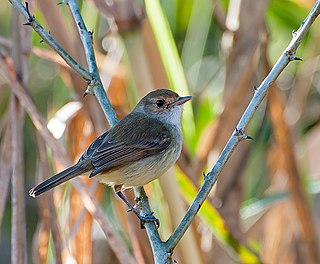
The fulvous-crowned scrub tyrant, or tawny-crowned pygmy-tyrant, is a species of bird in the family Tyrannidae, the tyrant flycatchers. It is found in Argentina, Bolivia, Brazil, Colombia, Paraguay, Peru, Uruguay, and Venezuela.

The southern mouse-colored tyrannulet is a species of bird in subfamily Elaeniinae of family Tyrannidae, the tyrant flycatchers. It is found in Argentina, Bolivia, Brazil, Paraguay, Peru, and possibly French Guiana and Suriname.

The rough-legged tyrannulet is a species of bird in subfamily Elaeniinae of family Tyrannidae, the tyrant flycatchers. It is found in Argentina, Bolivia, Brazil, Paraguay, and Uruguay.
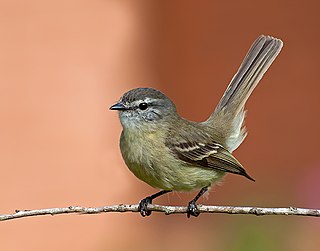
The planalto tyrannulet is a species of bird in subfamily Elaeniinae of family Tyrannidae, the tyrant flycatchers. It is found in Argentina, Bolivia, Brazil, and Paraguay.

Reiser's tyrannulet is a species of bird in subfamily Elaeniinae of family Tyrannidae, the tyrant flycatchers. It is found in Brazil and Paraguay.

Sclater's tyrannulet is a species of bird in subfamily Elaeniinae of family Tyrannidae, the tyrant flycatchers. It is found in Argentina, Bolivia, and Peru.

The greenish tyrannulet is a species of bird in subfamily Elaeniinae of family Tyrannidae, the tyrant flycatchers. It is found in Argentina, Brazil, Paraguay, and Uruguay.
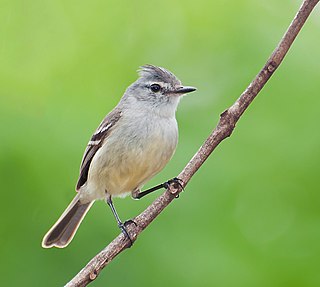
The white-crested tyrannulet is a small species of bird in the family Tyrannidae, the tyrant flycatchers. It is found in Argentina, Bolivia, Brazil, Paraguay, and Uruguay.

The yellow-crowned tyrannulet is a species of bird in subfamily Elaeniinae of family Tyrannidae, the tyrant flycatchers. It is found in Costa Rica, Panama, and in every mainland South American country except Argentina, Chile, Paraguay, and Uruguay.

The golden-faced tyrannulet is a species of bird in the family Tyrannidae, the tyrant flycatchers. It is found in Colombia, Ecuador, Peru, and Venezuela.

The red-billed tyrannulet is a species of bird in the family Tyrannidae, the tyrant flycatchers. It is found in Bolivia, Ecuador, and Peru.
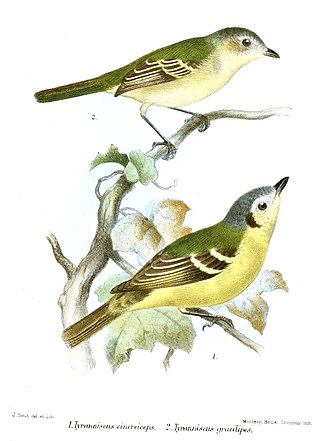
The slender-footed tyrannulet is a species of bird in the family Tyrannidae, the tyrant flycatchers. It is found in Bolivia, Brazil, Colombia, Ecuador, Peru, and Venezuela.
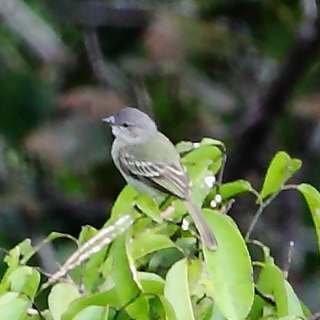
The Guianan tyrannulet is a species of bird in the family Tyrannidae, the tyrant flycatchers. It is found in Brazil, French Guiana, Guyana, Suriname, and Venezuela.
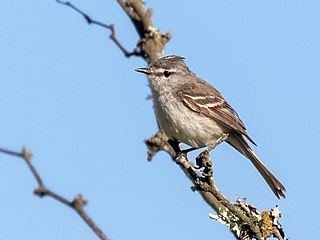
Straneck's tyrannulet, also known as the monte tyrannulet and grey-crowned tyrannulet, is a small species of bird in the family Tyrannidae, the tyrant flycatchers. It is found in Argentina, Bolivia, Brazil, Paraguay, and Uruguay.

The white-fronted tyrannulet is a species of bird in subfamily Elaeniinae of family Tyrannidae, the tyrant flycatchers. It is found in Bolivia, Colombia, Costa Rica, Ecuador, Panama, Peru, and Venezuela.

The small-headed elaenia, also known as the Brazilian elaenia, is a species of bird in subfamily Elaeniinae of family Tyrannidae, the tyrant flycatchers. It is found in Argentina, Brazil, Paraguay, and Uruguay.

The Chilean elaenia is a species of bird in subfamily Elaeniinae of family Tyrannidae, the tyrant flycatchers. It is found in Argentina, Bolivia, Brazil, Chile, Colombia, Paraguay, Peru, and Uruguay.























